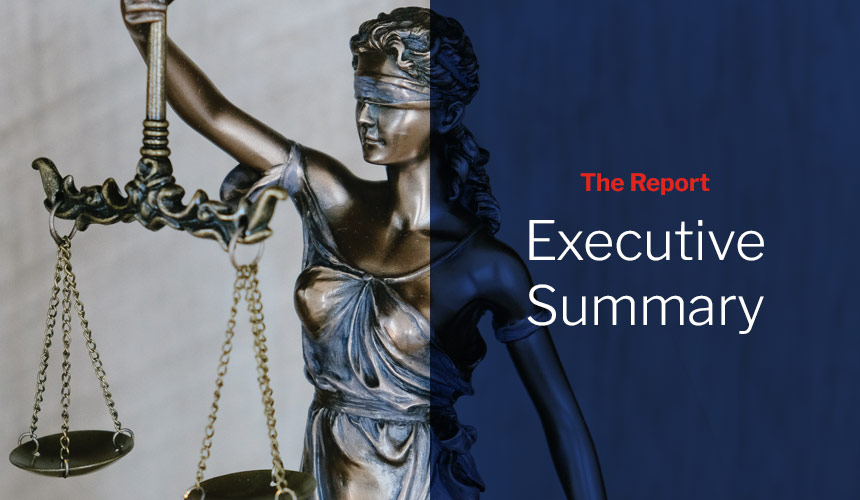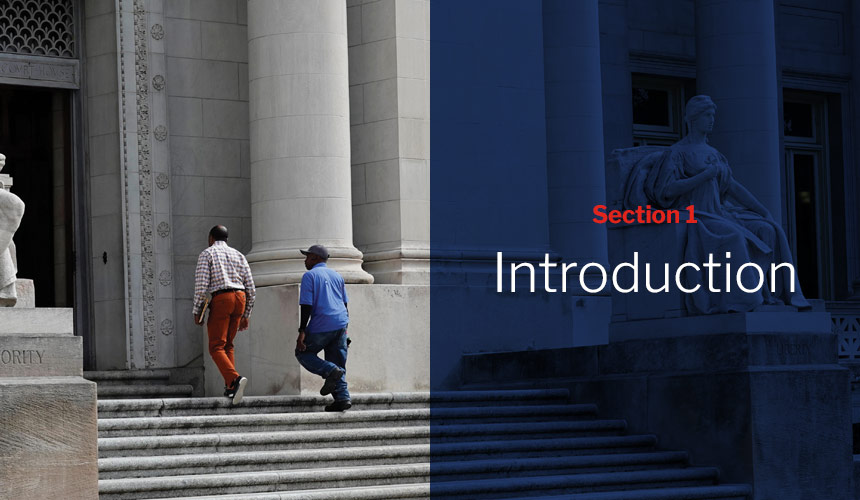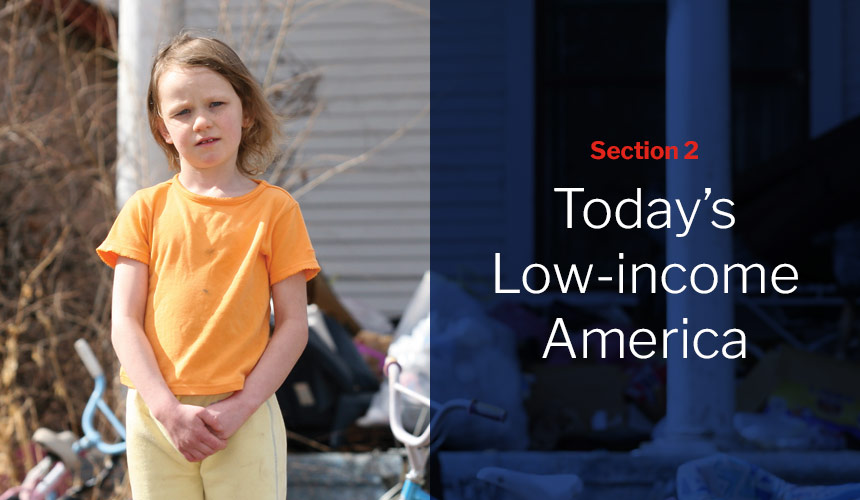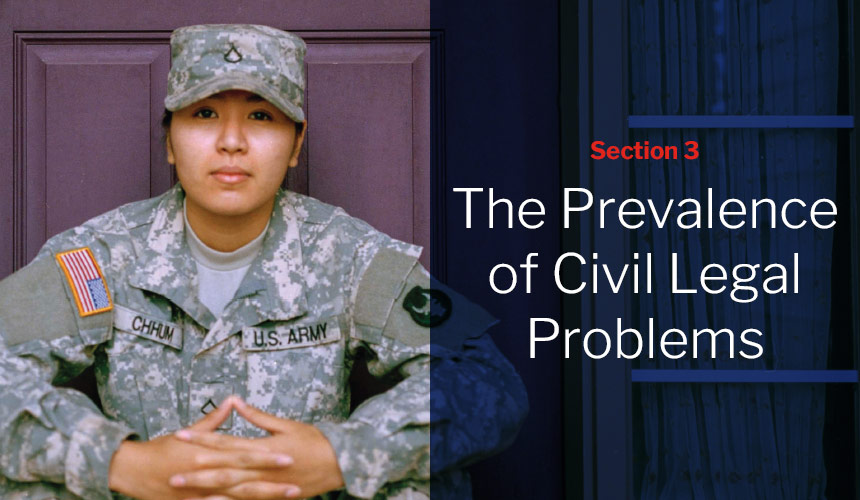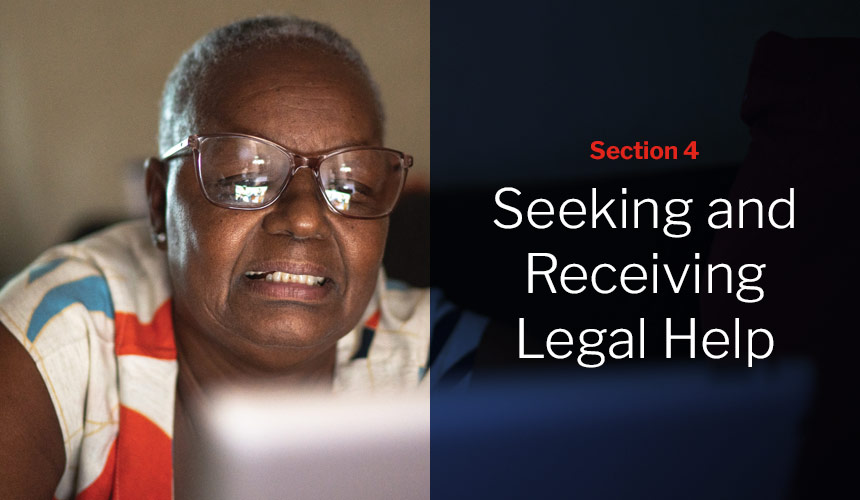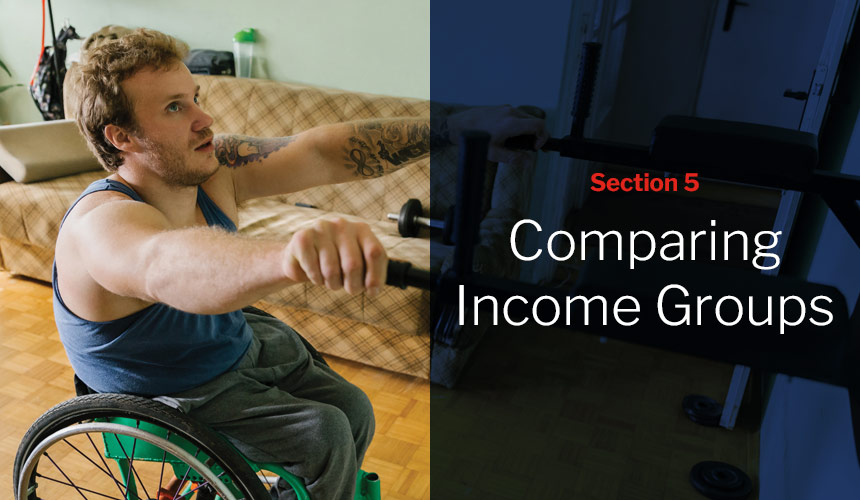1 While not common, the right to counsel for civil legal matters exists in some places and for some types of legal matters. For example, the right to counsel exists for eviction cases in the states of Connecticut, Maryland, and Washington and in several cities. For the most up-to-date information on the civil right to counsel, see: http://civilrighttocounsel.org/.
2 The regional categorization used by the U.S. Census Bureau can be found here: https://www2.census.gov/geo/pdfs/maps-data/maps/reference/us_regdiv.pdf.
3 We define these groups in the following ways for the purposes of this report: “seniors” typically refers to people who are 65 years or older, though information based on LSC’s Grantee Activity Reports treats anyone 60 years old or older as a “senior;” “veterans” refers to anyone who has served in the military, military reserves, or national guard; for survey data, “rural” refers to nonmetro counties as coded in the U.S. Department of Agriculture (USDA) Economic Research Service’s 2013 Rural-Urban Continuum Codes (see: https://www.ers.usda.gov/data-products/rural-urban-continuum-codes/documentation/); for U.S. Census data, “rural” refers to nonmetro areas; “children” refers to individuals under 18 years old; for survey data, “recent survivors of domestic violence” refers to individuals who report having experienced domestic violence in the past 12 months; someone is considered to have “high housing costs” if they spend more than 50% of their household income on housing expenses (consistent with the definition used by the U.S. Department of Housing and Urban Development).
4 The client stories are based on information that LSC-funded organizations have shared with LSC to provide examples of how the provision of legal assistance impacted clients.
5 Note that some of the client stories featured in this report are also featured in study-related videos hosted on the study website: justicegap.lsc.gov. The clients featured in the videos authorized the use of their images and names for the purposes of the videos.
6 See NORC’s 2021 Justice Gap Measurement Survey technical report for details about the differences between the 2017 and 2021 surveys; this report can be found on the study website: justicegap.lsc.gov.
7 Source: U.S. Census Bureau, Table: Poverty Thresholds for 2021 by Size of Family and Number of Related Children Under 18 Years (accessed in April 2022); the household income for a family of four assumes the family consists of two adults under 65 years old with two dependent children, and the household income for an individual assumes the individual is under 65 years old.
8 Source: U.S. Census Bureau, Current Population Survey, 2021 Annual Social and Economic Supplement (CPS ASEC). Table POV46: Poverty Status by State: 2020 (accessed in March 2022).
9 An estimated 87% of the general U.S. population lives in a metropolitan area; source: U.S. Census Bureau, Current Population Survey, 2021 Annual Social and Economic Supplement (CPS ASEC). Table POV40 (by region): Age, Sex, and Household Relationship of People by Region and Residence – Ratio of Income to Poverty Level: 2020 (accessed in March 2022).
10 Source: U.S. Census Bureau, Current Population Survey, 2021 Annual Social and Economic Supplement (CPS ASEC). Table POV40: Age, Sex, and Household Relationship of People by Region and Residence – Ratio of Income to Poverty Level: 2020 (accessed in March 2022).
11 Source: U.S. Census Bureau, Current Population Survey, 2021 Annual Social and Economic Supplement (CPS ASEC). Table POV01: Age and Sex of All People, Family Members and Unrelated Individuals: 2020 (accessed in March 2022).
12 Source: U.S. Census Bureau, Current Population Survey, 2021 Annual Social and Economic Supplement (CPS ASEC). Table POV01: Age and Sex of All People, Family Members and Unrelated Individuals: 2020 (accessed in March 2022).
13 Source: U.S. Census Bureau, Current Population Survey, 2021 Annual Social and Economic Supplement (CPS ASEC). Table POV04: Primary Families by Age of Householder, Number of Children, and Family Structure: 2020 (accessed in March 2022).
14 Source: U.S. Census Bureau, Current Population Survey, 2021 Annual Social and Economic Supplement (CPS ASEC). Table POV01: Age and Sex of All People, Family Members and Unrelated Individuals: 2020 (accessed in March 2022).
15 Source: U.S. Census Bureau, 2019 American Community Survey (ACS); estimates were produced through IPUMS USA database (accessed March 2022): Ruggles, S., Flood, S., Foster, S., Goeken, R., Pacas, J., Schouweiler, M., Sobek, M. 2021. IPUMS USA: Version 11.0 [dataset]. Minneapolis, MN: IPUMS.
16 See, for example: Chen, J. T., & Krieger, N. 2021. Revealing the Unequal Burden of COVID-19 by Income, Race/Ethnicity, and Household Crowding: US County Versus Zip Code Analyses. Journal of Public Health Management and Practice: JPHMP, 27 Suppl 1, COVID-19 and Public Health: Looking Back, Moving Forward, S43–S56; Quan, D., Luna Wong, L., Shallal, A., Madan, R., Hamdan, A., Ahdi, H., Daneshvar, A., Mahajan, M., Nasereldin, M., Van Harn, M., Opara, I. N., & Zervos, M. 2021. Impact of Race and Socioeconomic Status on Outcomes in Patients Hospitalized with COVID-19. Journal of General Internal Medicine, 36(5), 1302–1309; Finch, W. H., & Hernández Finch, M. E. 2020. Poverty and Covid-19: Rates of Incidence and Deaths in the United States During the First 10 Weeks of the Pandemic. Frontiers in Sociology, 5, 47.
17 With the help of the Institute for Research on Poverty at the University of Wisconsin-Madison, the Office of the Assistant Secretary for Planning & Evaluation (ASPE) in the U.S. Department of Health & Human Services (HHS) produced a brief summarizing the impact of the first year of the pandemic on low-income families: “The Impact of the First Year of the COVID-19 Pandemic and Recession on Families with Low Incomes” (September 2021) (https://aspe.hhs.gov/sites/default/files/2021-09/low-income-covid-19-impacts.pdf).
18 Source: U.S. Census Bureau, Household Pulse Survey, Week 43 (March 2 – 14). Tables: Employment Table 1, Food Sufficiency and Food Security Table 1, Health Table 2a, and Housing Table 1b (accessed in March 2022).
19 Source: U.S. Census Bureau, Current Population Survey, 2021 Annual Social and Economic Supplement (CPS ASEC). Table POV40: Age, Sex, and Household Relationship of People by Region and Residence – Ratio of Income to Poverty Level: 2020 (accessed in March 2022).
20 The information on this page that pertains to seniors, households with children, and people in rural areas come from: U.S. Census Bureau, Current Population Survey, 2021 Annual Social and Economic Supplement (CPS ASEC), various tables (accessed in March 2022); the information pertaining to veterans comes from: U.S. Census Bureau, 2019 American Community Survey (ACS) and the estimates were produced through IPUMS USA database (accessed March 2022): Ruggles, S., Flood, S., Foster, S., Goeken, R., Pacas, J., Schouweiler, M., Sobek, M. 2021. IPUMS USA: Version 11.0 [dataset]. Minneapolis, MN: IPUMS; the information that pertains to people with high housing costs comes from: U.S. Census Bureau, 2019 American Housing Survey (AHS) using the AHS Table Creator in March 2022 (national 2019 housing costs by household income, no filters); the information that pertains to survivors of domestic violence comes from: Bonomi, A. E., Trabert, B., Anderson, M. L., Kernic, M. A., & Holt, V. L. 2014. Intimate partner violence and neighborhood income: a longitudinal analysis. Violence against women, 20(1), 42–58.
21 Source: 2021 Justice Gap Measurement Survey; results based on count of respondents’ reports of problems personally experienced and experienced by others in household in the past year from among 81 distinct problems. Note that a given problem can only be counted once per household. For a full list of the 81 problems, see the questionnaire on the study website: justicegap.lsc.gov.
22 Source: 2021 Justice Gap Measurement Survey; for information about how specific problems were categorized into problem types, see NORC’s 2021 Justice Gap Measurement Survey technical report on the study website: justicegap.lsc.gov.
23 Source: 2021 Justice Gap Measurement Survey; n = 1,194 homeowner households.
24 Source: 2021 Justice Gap Measurement Survey; note that the prevalence rate of experiencing a problem related to disability is 16% for households with someone who either has a disability or cares for a loved one who does (n=1,152 households).
25 For example, see: Pleasence, P., Balmer, N.J., Buck, A., O’Grady, A., and Glenn, H. 2004. Multiple justiciable problems: common clusters, problem order and social and demographic indicators. Journal of Empirical Legal Studies, 1(2): 201-329; Desmond, Matthew. 2017. Evicted: Poverty and Profit in the American City. Penguin Books; Tobin Tyler, E., Lawton, E., Conroy, K., Sandel, M. and Zuckerman, B. 2011. Poverty, Health and Law: Readings and Cases for Medical-legal Partnerships. Durham, NC: Carolina Academic Press.
26 Note that, here, “eviction households” refers to households for which a respondent reported that they or another household member had experienced a civil legal problem related to eviction in the past year (e.g., falling behind on rent or receiving an eviction notice); likewise, “domestic violence households” refers to households for which a respondent reported that they or another household member had experienced domestic violence of some sort in the past year.
27 Source: 2021 Justice Gap Measurement Survey; note that the estimates for eviction households reflect problems in addition to eviction-related ones (problems related to eviction are not included in the count); the same is true for estimates for domestic violence households – they are in addition to problems involving domestic violence.
28 Source: 2021 Justice Gap Measurement Survey; Q4A – Q4E; Q4A: Overall, how much would you say this problem has negatively affected you or others in your household? Q4B – Q4E: How much has this problem negatively affected the [impact area] of/for you or any other person in your household? Impact areas: physical health or safety, mental or emotional health, financial situation, relationships with family members and others); response options for Q4A – Q4E: severely, very much, moderately, slightly, not at all. Note that survey items Q4B – Q4E were not presented to respondents who answered “not at all” to Q4A; to produce the proportions in this figure for the entire low-income sample of individuals, we assume these respondents would have answered “not at all” to Q4B – Q4E and code them accordingly (this increases the denominator used in estimates and potentially leads to an underestimation of the
proportion of people who were substantially impacted in those specific areas).
29 Source: 2021 Justice Gap Measurement Survey; the results in this figure are based on Q4A (see previous endnote for question wording and response options). For a given category, the percentage reported reflects the proportion of individuals — among all who personally experienced at least one problem in that category — who indicated that at least one problem in the category had negatively affected them “very much” or “severely” overall.
30 Source: 2021 Justice Gap Measurement Survey; Q3: Do you think this problem was related to the COVID-19 pandemic or circumstances surrounding the COVID-19 pandemic? Response options: yes, no, not sure. For each set of individuals (differentiated by characteristics of their households), the percentage reported reflects the proportion of individuals — among all those in the set who personally experienced at least one problem — who indicated that at least one of their personally experienced problems was related to the COVID-19 pandemic. Note that “households with children < 12 yrs” are actually households with parents of children < 12 years old; it is possible that the children do not actually live in the same household.
31 Source: 2021 Justice Gap Measurement Survey.
32 Source: 2021 Justice Gap Measurement Survey; note that we consider a respondent’s household to have “recent domestic violence” if the respondent indicated that they or someone else in the household had experienced a problem involving domestic violence in the past 12 months; note also that “households with children (<18 yrs)” are actually households with parents of children < 18 years old; it is possible that the children do not actually live in the same household.
33 Note that several estimates related to seeking legal help in this section differ from those presented in NORC’s technical survey report because our analysis includes some observations that were not included in the analysis informing that report; more specifically, we include cases where the respondent initially said they did not speak with a legal professional in Q5, but later indicated that they had
unsuccessfully tried to speak a legal professional in Q6.
34 Source: 2021 Justice Gap Measurement Survey; we count a respondent as having sought legal help for any problem for which they answered “yes” to Q5 or “I tried, but I wasn’t able to talk to a legal professional” to Q6. Q5: At any time while you were dealing with this problem, did you do any of the following? Talk to a lawyer or legal professional about the problem. Response options: yes, no. Q6: Why
haven’t you talked to a lawyer or other legal professional about this problem? I tried, but I wasn’t able to talk to a legal professional.
35 This finding is consistent with 2017 results – but note that the 2017 Justice Gap report discussed problems related to children and custody as separate from other family matters.
36 Source: 2021 Justice Gap Measurement Survey; Q5 and Q6 (see endnote 34).
37 Source: 2021 Justice Gap Measurement Survey; Q8: What kind of legal help did you want when you decided to talk to a lawyer or other legal professional? Response options: learning where to look for legal information online; help filling out a legal document or form; handling communication with the other people involved in the issue (including demand letters); legal advice about your specific situation and what actions you should take; help negotiating with the other people involved in the issue; representation by a lawyer or other legal professional in court, including filing court documents; other; none of the above. Note: these estimates correspond only to the set of respondents who said that they spoke to a legal professional for a given problem in Q5; it does not include people who indicated that they tried to speak to someone but were not able to do so in Q6.
38 Source: 2021 Justice Gap Measurement Survey; Q10: As of today, have you been able to get as much legal help with this issue as you wanted? Response options: yes, no; base n=1,059 problems.
39 Source: 2021 Justice Gap Measurement Survey; Q10 (see previous endnote); base n=635 problems.
40 For more information about this survey-based measure of the justice gap – including how it might underestimate or overestimate the justice gap – please see the additional information provided on the study website: justicegap.lsc.gov.
41 Reminder: As discussed in the “about the data” information for this section, the number of problems considered was capped at 10 problems per respondent; readers can find additional information on the study website: justicegap.lsc.gov.
42 This is based on items Q5 and Q6 in the 2021 Justice Gap Measurement Survey.
43 This is based on item Q10 in the 2021 Justice Gap Measurement Survey.
44 Source: 2021 Justice Gap Measurement Survey; additional details on how the survey-based estimates of the justice gap were produced can be found on the study website: justicegap.lsc.gov.
45 Source: 2021 Justice Gap Measurement Survey; Q2 (see previous endnote).
46 See NORC’s 2021 Justice Gap Measurement Survey technical report for a discussion of the measurement strategy for these survey items, including a consideration of the utility of agreement scales in this case.
47 Source: 2021 Justice Gap Measurement Survey; Q16 – Q18: To what extent do you agree or disagree with the statement below? People like me are able to use the civil legal system to protect and enforce their rights; people like me are treated fairly in the civil legal system; the civil legal system can help people like me solve important problems like those discussed in this survey. Response options: strongly agree, somewhat agree, neither agree nor disagree; somewhat disagree; strongly disagree. Numbers do not total to 100% due to rounding and a small percent of respondents who did not provide a response.
48 Source: 2021 Justice Gap Measurement Survey; Q15: How confident are you that you would be able find a lawyer or other professional that you could afford if you needed help on a serious civil legal problem, such as preventing an eviction, foreclosure, or the loss of custody of a child? Response options: extremely confident, very confident, somewhat confident, not too confident, not at all confident. Numbers do not total to 100% due to rounding and a small percent of respondents who did not provide a response.
49 Source: 2021 Justice Gap Measurement Survey; n=1264; Q6: Why haven’t you talked to a lawyer or other legal professional about this problem? I was worried about the cost.
50 Source: 2021 Justice Gap Measurement Survey; n=110* (*small base); Q11: Why haven’t you gotten all the legal help you wanted? Too expensive to get more help.
51 Source: 2021 Justice Gap Measurement Survey; n=946; Q5: At any time while you were dealing with this problem, did you do any of the following? Talk to a lawyer or legal professional about the problem. Response options: yes, no.
52 Source: 2021 Justice Gap Measurement Survey; Q6, n=621 respondents; 38% and 33% of low-income Americans offered these reasons, respectively, to explain why they did not seek help for one or more of their COVID-attributed problems.
53 Source: 2021 Justice Gap Measurement Survey.
54 Source: 2021 Justice Gap Measurement Survey; results regarding seeking legal help come from items Q5 and Q6; results regarding receiving any or enough help are based on the survey-based justice gap measure.
55 Source: 2021 Justice Gap Measurement Survey; results regarding seeking legal help come from items Q5 and Q6; results regarding receiving any or enough help are based on the survey-based justice gap measure; note that “households with children (<18 yrs)” are actually households with parents of children < 18 years old; it is possible that the children do not actually live in the same household.
56 Note that these figures are based on the poverty guidelines for the 48 contiguous states and the District of Columbia; they are separate guidelines for Hawaii and Alaska.
57 Source: 2022 Poverty Guidelines from the Department of Health and Human Services as published in the Federal Register (January 21, 2022), Vol. 87, No. 14 https://www.govinfo.gov/content/pkg/FR-2022-01-21/pdf/2022-01166.pdf).
58 Source: 2021 Justice Gap Measurement Survey; Q5: At any time while you were dealing with this problem, did you do any of the following? Talk to a lawyer or legal professional about the problem. Response options: yes, no.
59 Source: 2021 Justice Gap Measurement Survey; this impact differential was calculated by subtracting the percent seeking help for problems with less impact from the percent seeking help for problems with substantial impact for each income group. See Table 5B for the numbers used in the calculation.
60 Source: 2021 Justice Gap Measurement Survey; additional details on how the survey-based estimates of the justice gap were produced can be found on the study website: justicegap.lsc.gov.
61 Source: 2021 Justice Gap Measurement Survey; this impact differential was calculated by subtracting the survey-based justice gap measure for problems with less impact from the survey-based justice gap measure for problems with substantial impact for each income group. See Table 5C for the numbers used in the calculation.
62 Source: 2021 Justice Gap Measurement Survey; Q2: In your opinion, is this a type of problem that a lawyer or other legal professional could help resolve? Response options: yes, no, not sure.
63 Source: 2021 Justice Gap Measurement Survey; Q16 – Q18: To what extent do you agree or disagree with the statement below? People like me are able to use the civil legal system to protect and enforce their rights; people like me are treated fairly in the civil legal system; the civil legal system can help people like me solve important problems like those discussed in this survey. Response options: strongly agree, somewhat agree, neither agree nor disagree; somewhat disagree; strongly disagree. See NORC’s 2021 Justice Gap Measurement Survey technical report for a discussion of the measurement strategy for these survey items. Figure reports percent saying they strongly agree or somewhat agree.
64 Source: 2021 Justice Gap Measurement Survey; Q15: How confident are you that you would be able find a lawyer or other professional that you could afford if you needed help on a serious civil legal problem, such as preventing an eviction, foreclosure, or the loss of custody of a child? Response options: extremely confident, very confident, somewhat confident, not too confident, not at all confident. Figure reports percent saying they are at least somewhat confident.
65 Source: 2021 Justice Gap Measurement Survey; Q3: Do you think this problem was related to the COVID-19 pandemic or circumstances surrounding the COVID-19 pandemic? Response options: yes, no, not sure. n=1,466 for <=125% of FPL, n=549 for >=400% of FPL.
66 Source: 2021 Justice Gap Measurement Survey; additional details on how the survey-based estimates of the justice gap were produced can be found on the study website: justicegap.lsc.gov.
67 Source: 2021 Justice Gap Measurement Survey; Q15: How confident are you that you would be able find a lawyer or other professional that you could afford if you needed help on a serious civil legal problem, such as preventing an eviction, foreclosure, or the loss of custody of a child? Response options: extremely confident, very confident, somewhat confident, not too confident, not at all confident. Figures in this snapshot reflect the percent saying they are at least somewhat confident.
68 Source: 2021 Justice Gap Measurement Survey; see previous endnote. Also note that “households with children (<18 yrs)” are actually households with parents of children < 18 years old; it is possible that the children do not actually live in the same household.
69 Note that while the overwhelming majority of individuals served by LSC-funded organizations have household incomes at or below 125% of FPL, LSC regulations allow funds to be used to serve individuals with incomes up to 200% of FPL; see 45 CFR § 1611.5(a) (3) and (4).
70 For information about current statutory and regulatory restrictions on the use of LSC funds, please see the overview on LSC’s website: https://www.lsc.gov/about-lsc/laws-regulations-and-guidance/lsc-restrictions-and-other-funding-sources.
71 It is important to note that, for the purposes of this analysis and report, we exclude requests for assistance that were not accepted due to conflicts of interest. These cases are technically “eligible” based on the criteria presented in this report, but LSC-funded organizations are nonetheless unable to serve them due to conflicts of interest. These cases constitute a very small portion of the overall requests for assistance. Note that other LSC publications include these cases in their analysis and estimates and therefore might have slightly different estimates.
72 Throughout this section, all counts and estimates include “pending” cases; organizations have determined that these cases were eligible for assistance, but had not yet determined whether or how much service the cases would receive. There were 17,730 pending cases (out of a total of 146,724 eligible cases). For the purpose of this analysis, these cases were distributed proportionately across service categories.
73 Source: LSC’s 2021 Intake Census.
74 Source: LSC’s 2021 Intake Census.
75 For example, see Figure 4.2A in LSC’s 2020 “By the Numbers” publication; Lim, L., Layton, J., Abdelhadi, S., Bernstein, D., Ahmed, R. 2021. LSC By the Numbers: The Data Underlying Legal Aid Programs (2020). Legal Services Corporation, Washington, D.C.
76 LSC-funded organizations conduct comprehensive legal needs assessments in their communities on a regular basis to inform these guidelines.
77 Source: LSC’s 2021 Intake Census. These figures reflect only the cases for which the level of service was determined (i.e., pending cases are not included).
78 Source: LSC’s 2021 Intake Census.
79 Source: LSC’s 2021 Intake Census; the counts and estimates are rounded to the nearest thousand. Annual estimates are projected counts for the entire year, assuming that the intake census four-week period represents a typical four-week period for intake activity. The annual estimates were produced this way: (count) x (52.14/4) = annual estimate.
80 Source: Lim, L., Layton, J., Abdelhadi, S., Bernstein, D., Ahmed, R. 2021. LSC By the Numbers: The Data Underlying Legal Aid Programs (2020). Legal Services Corporation, Washington, D.C.
81 The information corresponding to the cases, households, and individuals served by LSC-funded organizations in 2021 comes from LSC’s preliminary analysis of 2021 Grantee Activity Report (GAR) data. GAR is the largest and longest-running data collection effort on civil legal aid in the United States. Since 1976, LSC has recorded and reported data from grantees in a variety of ways. Topics include grantee staffing, finances, case services, and more. Data collection occurs in the first quarter of each year. LSC reports GAR data in its annual “By the Numbers” publication; the 2021 publication is forthcoming. The information about the Rural Summer Legal Corps program comes from: Lim, L., Layton, J., Abdelhadi, S., Bernstein, D., Ahmed, R. 2021. LSC By the Numbers: The Data Underlying Legal Aid Programs (2020). Legal Services Corporation, Washington, D.C.

